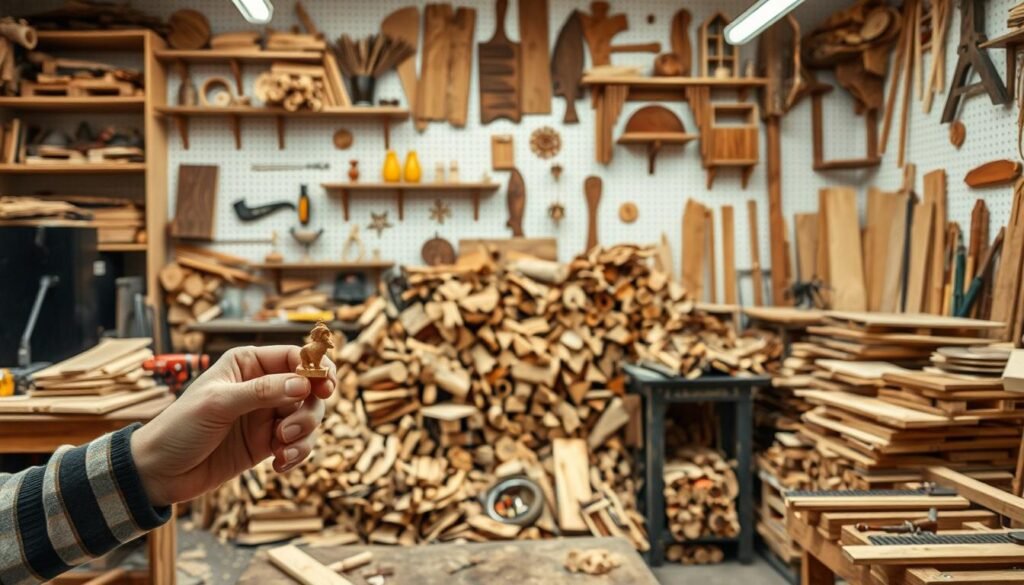Creating something with your own hands is rewarding, even more so when shared with loved ones. A DIY wood project is a great way to spend quality time together. It fosters bonding and makes memories that last forever.
Woodworking as a family promotes teamwork and encourages creativity and problem-solving. For beginners, starting with simple projects is a good way to get into DIY woodworking.
Adding a family wood project to your weekend routine can create a fun tradition. It becomes a cherished activity that brings everyone together. It also gives a sense of accomplishment.
Building Bonds Through Sawdust and Creativity
Woodworking brings families closer together, making memories with sawdust and creativity. Family woodworking projects unite family members through a shared activity. This promotes unity and cooperation.
Working on DIY wood projects helps families spend quality time together. It strengthens their bond and gives a sense of accomplishment. This is great for kids, teaching them problem-solving, patience, and creativity.
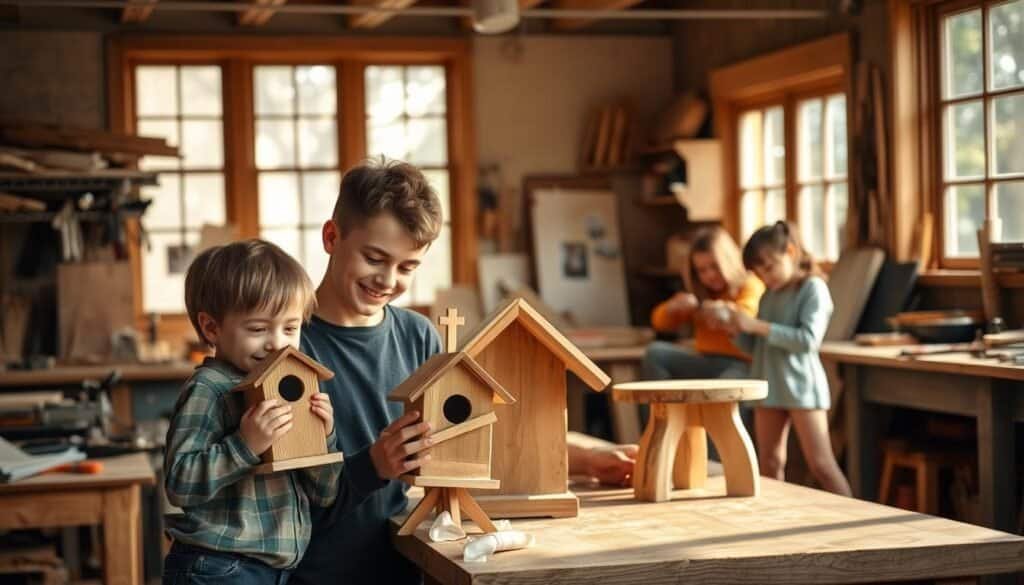
Creating memories through woodworking is key. Families make wooden items and lasting memories. Whether it’s a birdhouse or furniture, making it together strengthens family ties.
Woodworking projects for families fit all ages and skill levels. This makes it fun for everyone. It helps families appreciate craftsmanship and the value of handmade items.
Adding family bonding activities like woodworking to your routine changes your relationships. It’s a chance to leave screens behind and enjoy a creative activity together.
The Family Wood Project That’ll Become a Weekend Tradition
Woodworking as a family can be a fun and rewarding hobby. It’s full of creativity and bonding. The key is to pick a project that fits your family’s skill level and interests.
When picking a project, think about your family’s ages and abilities. Younger kids can start with simple birdhouses or wooden picture frames. These projects are fun and help improve fine motor skills and hand-eye coordination.
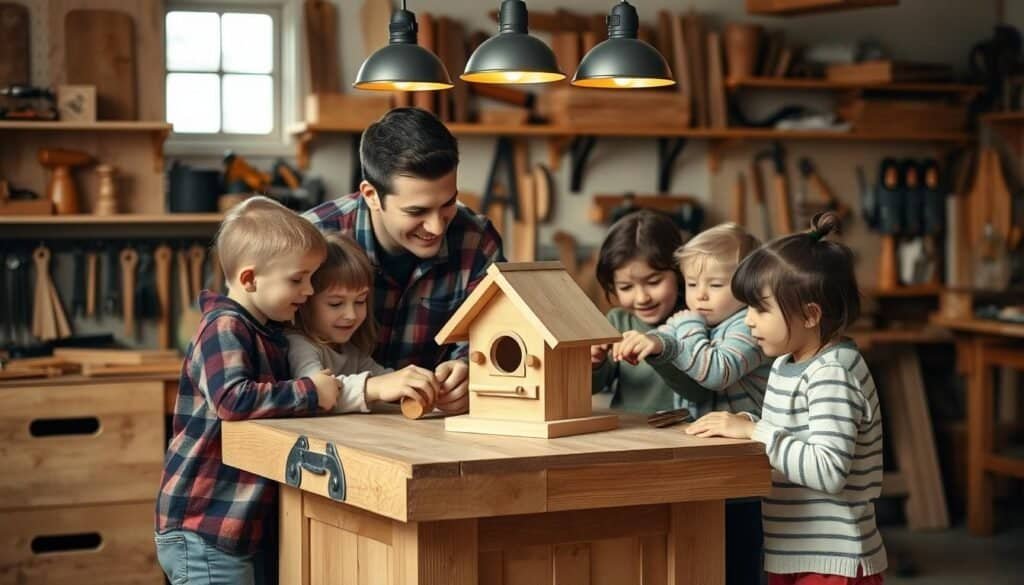
Older kids or teenagers can tackle more complex projects. Building a wooden bench or a treehouse can be exciting. These projects need more planning and skill but can create beautiful, functional pieces that become part of your family’s heritage.
To make woodworking a regular weekend activity, set up a dedicated workspace. It should be safe and easy for everyone to access. Make sure your workshop is well-organized, with tools and materials within easy reach.
Building traditions with woodcraft is more than just creating something. It’s about spending time together as a family. Make the experience enjoyable by playing music, sharing stories, or just enjoying each other’s company while working on your project.
By adding woodworking to your weekend routine, you create something with your hands and build memories. Whether it’s a simple DIY project or a more complex endeavor, creating together strengthens bonds and fosters a sense of accomplishment.
Essential Tools for Family-Friendly Woodworking
Starting a woodworking project with your family needs the right tools. These tools make the project safe and fun for everyone. They also teach kids important skills and safety habits.
Safety equipment is very important in family woodworking. You’ll need safety glasses, hearing protection, and dust masks. It’s key that everyone knows why they must wear these items.
You’ll also need basic woodworking tools. A table saw or circular saw is great for straight cuts. A drill press is good for precise drilling. Hand tools like chisels, hand saws, and sandpaper are essential for fine details.
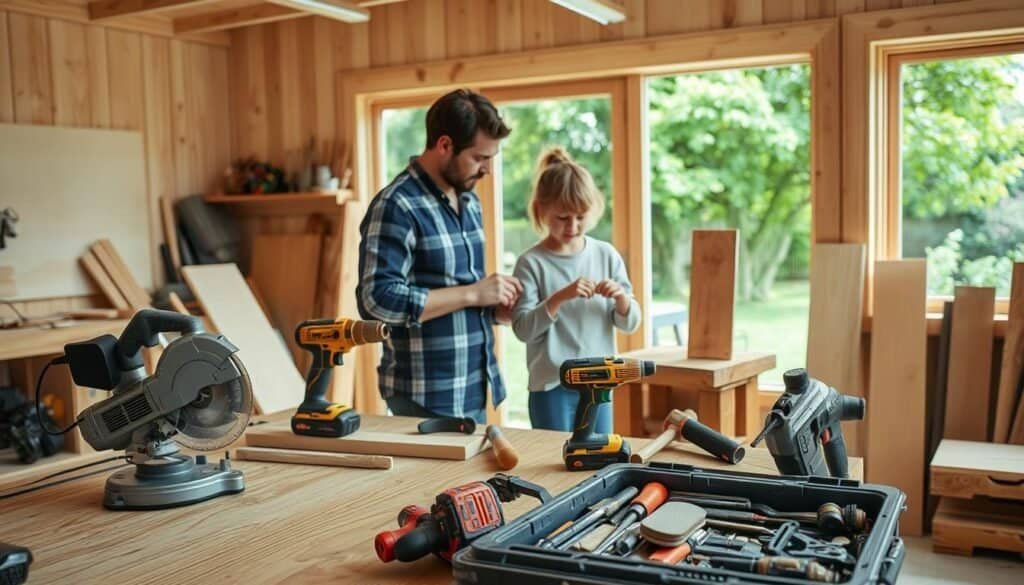
Don’t worry if you can’t buy all the tools at once. Start with the basics and add more as you get better. Making a diy corner shelf or a rustic corner shelf with natural wood is a good place to begin.
Having a good workspace is also important. It should be well-ventilated and organized. This makes it easier for everyone to find what they need and work well together.
In short, the right tools and a tidy workspace are essential for family woodworking. By focusing on safety and starting with the basics, you can make a fun project that brings your family closer.
Safety First: Creating a Family-Friendly Workshop
Creating a safe and fun woodworking space for your family is key. A safe workshop prevents injuries and encourages learning and creativity. It’s a place where everyone can enjoy making things together.
Teaching proper tool handling and storage is important. Make sure tools are in their places and teach kids how to use them safely. This helps keep everyone safe and builds their woodworking skills.
Keeping your workshop tidy is also essential. A clean space reduces the risk of accidents. Use safety gear like dust collectors and good lighting to protect eyes and improve visibility.
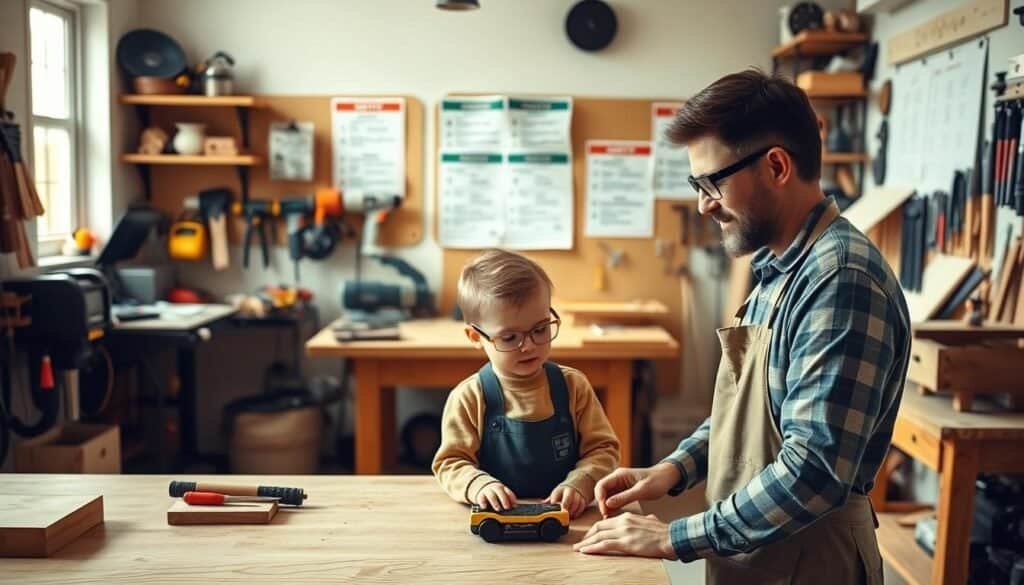
Setting clear safety rules is also vital. Ensure everyone wears protective gear like safety glasses and ear protection. Regularly check your workshop and tools for hazards and fix them quickly.
By focusing on safety and organization, woodworking can be a fun family activity. It not only improves your DIY projects but also brings your family closer through shared experiences.
Simple Starter Projects for Families with Young Children
For families with young kids, simple DIY wood projects are great. They encourage creativity and quality time together. We’ll look at two easy projects for families starting woodworking.
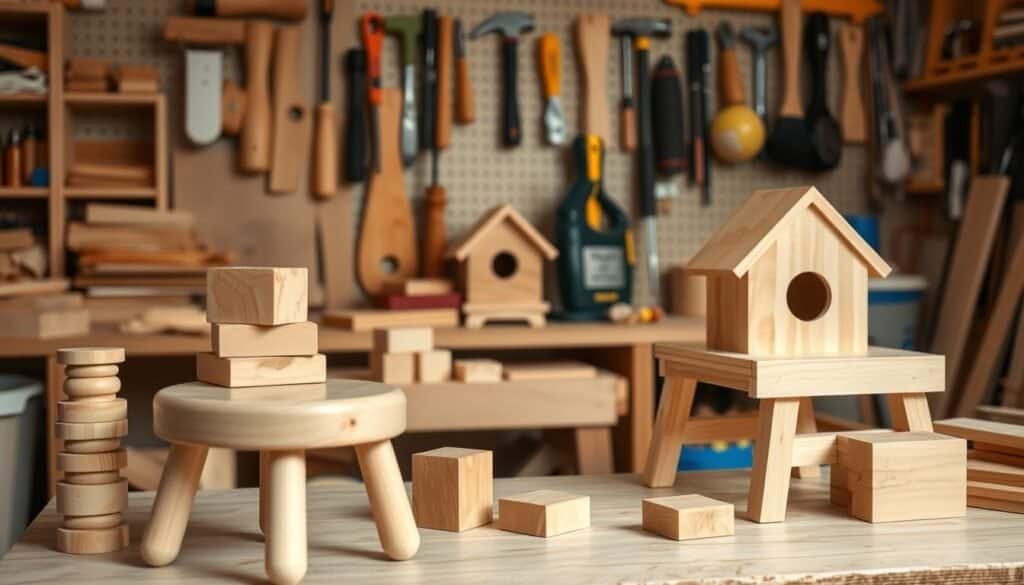
The first project is a wooden birdhouse. You’ll need 1-inch pine wood, a hammer, nails, a saw, and a drill. These materials and tools are easy to find and use, perfect for young families.
Step-by-Step Process
Start by cutting the pine wood into the birdhouse pieces. Use nails and a hammer to put it together. Drill a hole for the bird’s entrance and hang it on a tree. This project teaches kids about woodworking and helping wildlife.
Materials and Tools Needed
The second project is a wooden picture frame. You’ll need 1/2-inch plywood, a miter saw, wood glue, and clamps. It’s a fun way to make something for your home, teaching about measurements and tools.
Step-by-Step Process
Cut the plywood for the frame with a miter saw. Glue and clamp the pieces together until they dry. Then, decorate and use it for a family photo. This project improves kids’ fine motor skills and hand-eye coordination.
Both projects are designed to be fun and educational for families with young children. They lay the groundwork for more complex projects and create lasting memories.
Weekend Projects for Families with Tweens
When kids hit their tween years, they look for more challenging activities. This is a perfect time to introduce them to complex woodworking projects. Doing weekend projects is a great way to spend time together and learn new skills.
Creating a customized wooden desk organizer is a fun project for families with tweens. It teaches woodworking skills and gives them a useful item for school. It’s a great mix of DIY wood project and practical use.

To begin, you’ll need basic materials and tools. You’ll need a wooden plank, sandpaper, a drill, and a saw. Adding laser cut decor makes the final product even more special.
Step-by-Step Process
The first step is measuring and cutting the wood. Tweens can help with this, learning precision and technique. Then, sanding the edges and assembling the pieces is a fun family activity.
When it’s done, your tween can use it to keep their desk organized. It’s also a great wooden gift idea for others. This project shows how families with tweens can enjoy woodworking, making something useful and meaningful.
Working on projects like this strengthens family bonds and boosts creativity. It’s a wonderful way to spend weekends together, creating lasting memories.
Challenging Projects for Families with Teens
Working with teenagers, families can tackle detailed woodworking projects. These projects challenge and engage teens. They help improve their skills and build pride in their work.
Creating custom furniture, like a wooden coffee table or chair, is exciting. These tasks teach teens about precision and patience. They also learn about measurement, cutting, and assembly.
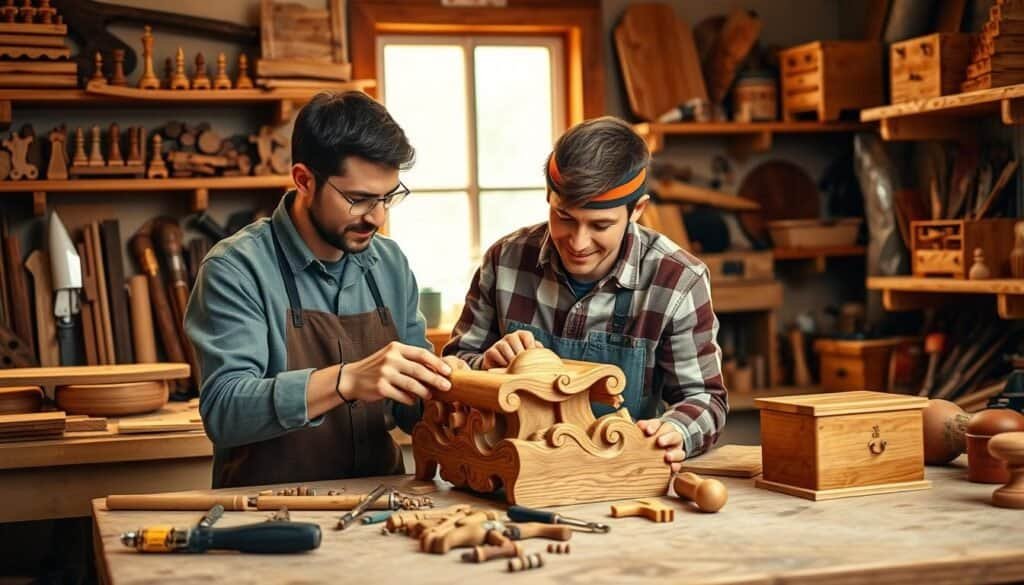
Making wooden decorations or signs with laser engraved ideas is another great project. It mixes traditional woodworking with modern tech. Teens learn about laser engraving and design software.
Building a wooden shed or a treehouse is a big challenge. These projects teach teens about planning, design, and teamwork. They also learn about safety and project management.
In conclusion, taking on challenging projects as a family is rewarding. It boosts teens’ skills, creativity, and teamwork. Families create lasting memories and beautiful pieces through these projects.
Seasonal Wood Projects to Mark the Calendar
Woodworking is a special way to celebrate the seasons. It lets families make decorations and gifts that become treasured family heirlooms. As the year goes on, families can take part in different DIY wood projects. These projects not only mark the passage of time but also create lasting memories.
Spring is a time of renewal, making it perfect for starting new family traditions. You can make wooden planters or birdhouses. Fill them with flowers or watch birds visit, symbolizing the return of life to your garden.
Summer brings warmth and long days, ideal for bigger projects. Building a wooden picnic table or making wooden garden markers is a fun way to spend time together.
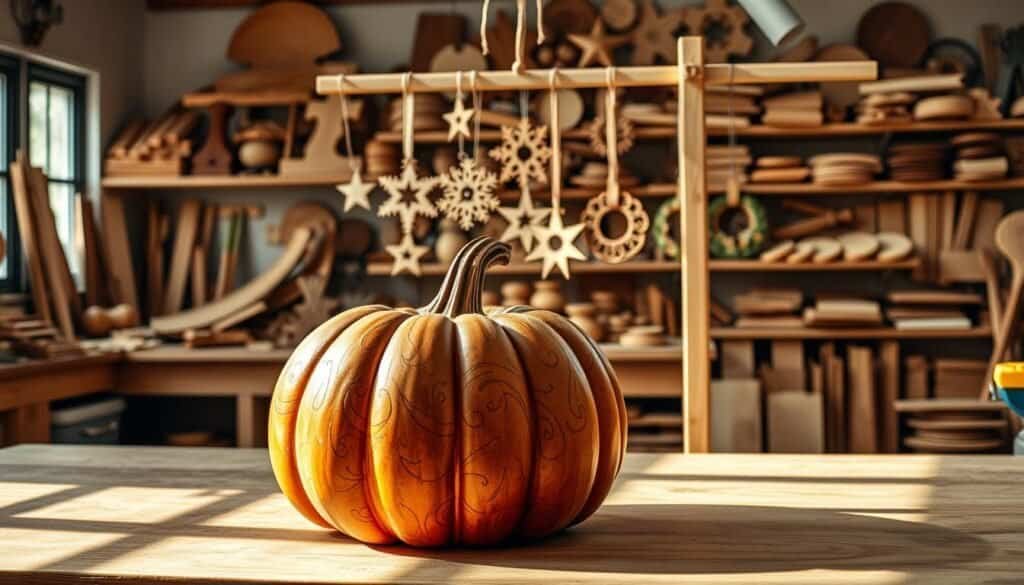
When autumn arrives, focus on projects that celebrate the harvest season. You can make wooden candle holders or a wooden advent calendar. These can become cherished annual traditions.
Winter, with its cozy atmosphere, is great for indoor woodworking projects. Families can make wooden ornaments, decorative coasters, or even a wooden Christmas tree stand. This makes the holiday season even more special.
By adding seasonal wood projects to your family’s activities, you create beautiful wooden things. You also make family time more meaningful, making the changing seasons even more special.
Personalized Wood Gifts: Creating for Others
You can make special personalized wood gifts with just a few tools and some creativity. These gifts are not only unique but also hold a deep meaning. They show how much you care about the person receiving them.
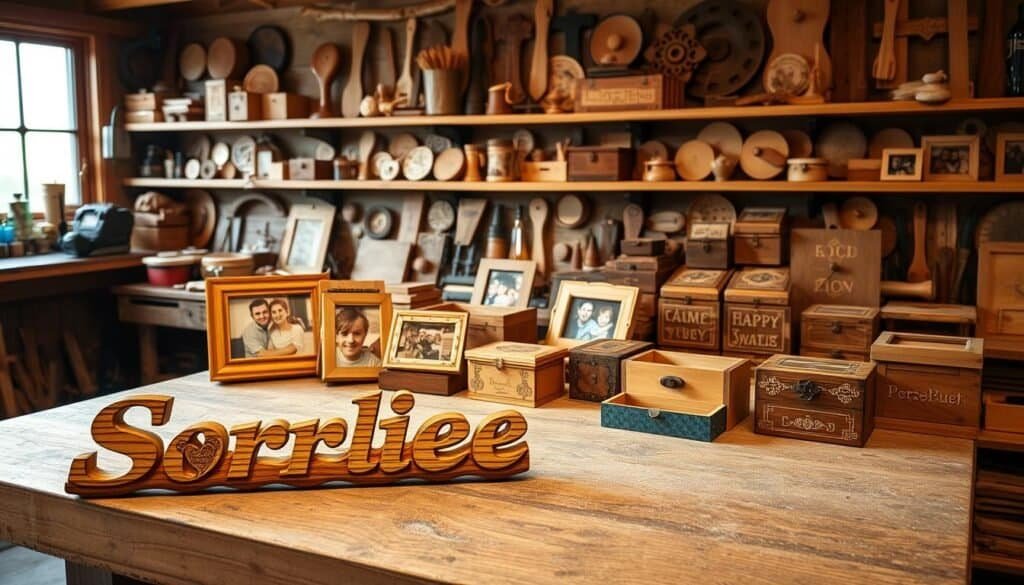
Laser engraving is a great way to make your gifts even more personal. It lets you add names, dates, or messages to your wooden creations. This makes them truly special and meaningful.
Laser Engraved Ideas for Special Occasions
Laser engraving is perfect for customized gifts for big events like weddings, anniversaries, and birthdays. For instance, you can engrave a wooden picture frame with the couple’s names and wedding date. Or, create a personalized wooden cutting board with a heartfelt message.
Small Wooden Projects with Big Impact
Small wooden projects can make a big difference in gifting. Think about making wooden coasters, candle holders, or small decorative boxes. These items are not only useful but also add warmth and personality to any space. Adding a personal touch, like a family icon or a special message, makes these gifts even more meaningful.
Making personalized wood gifts is a thoughtful way to show you care. It doesn’t matter if it’s a small token or a bigger project. The effort you put into making something handmade will be valued and cherished.
Documenting Your Family’s Woodworking Journey
Capturing memories of your family’s woodworking projects is a great way to cherish your time together. By documenting your journey, you can reflect on your progress and relive the moments that make woodworking so special.
One of the simplest ways to document your family’s woodworking journey is through photography. Taking clear, well-lit photos of your projects can help you capture their essence. Consider using a camera or smartphone with a good camera to take a 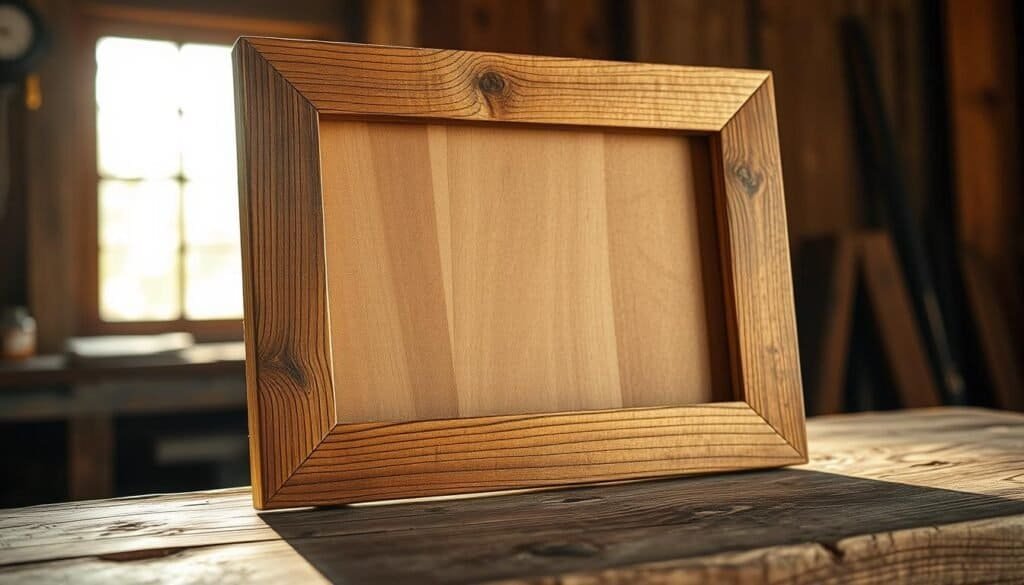
Keeping a project journal is another valuable way to record your progress. Write down the details of each project, including materials used, techniques employed, and challenges overcome. This will provide a rich history of your family’s woodworking journey.
Documenting your family’s woodworking journey is not just about recording your projects. It’s also about creating memories that will last a lifetime. By reflecting on your experiences and progress, you can deepen your appreciation for the craft and strengthen your family bonds.
As you continue on your family woodworking journey, consider sharing your experiences with others. Whether through social media, a blog, or simply sharing photos with friends and family, documenting your journey can be a great way to connect with others who share your passion for woodworking.
Overcoming Common Challenges in Family Woodworking
When families start woodworking together, they face many obstacles. These can include disagreements, mistakes, or frustrations with tools. These challenges are a normal part of the journey.
Keeping everyone safe in the workshop is a big challenge. To solve this, set clear safety rules. Make sure everyone knows and follows them. This means wearing protective gear and being careful around each other.
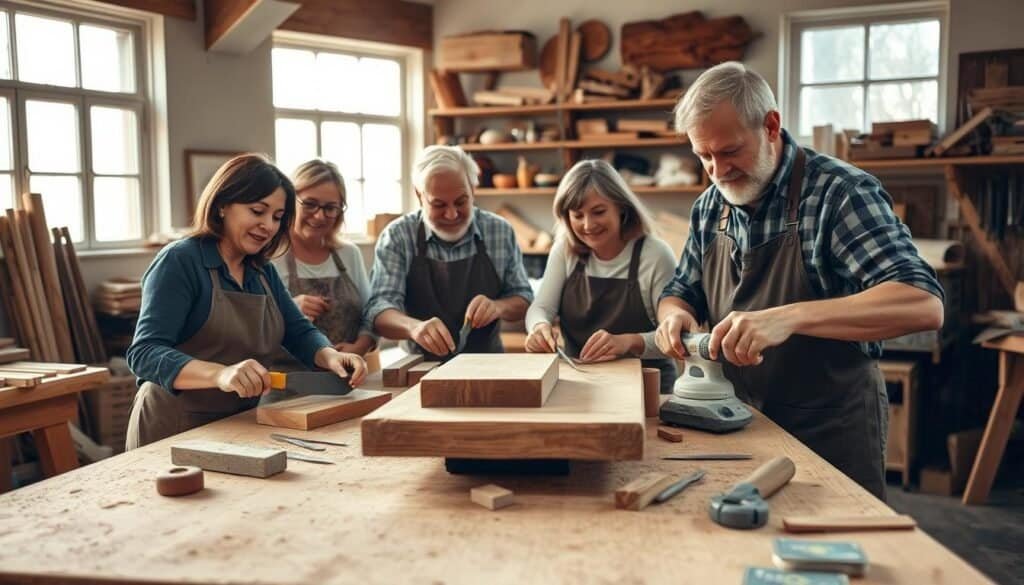
Managing different skills and interests is another challenge. Choose projects that everyone can help with, no matter their skill level. For beginners, start with simple projects to build confidence and skills.
Good communication is key to overcoming challenges. Talk openly about what’s working and what’s not. Be ready to change plans if needed. This makes the project successful and strengthens family bonds.
Seeing mistakes as learning chances can make a big difference. It helps families grow together, improving their woodworking and teamwork skills.
From Project to Tradition: Making Woodworking a Family Ritual
Woodworking can grow from a project into a family tradition. It becomes a shared experience passed down through generations. By making it a regular family activity, you create a sense of continuity.
To make woodworking a family tradition, start by setting a regular time for it. It could be weekly or monthly, depending on your family’s schedule. Consistency is key to making it a tradition.
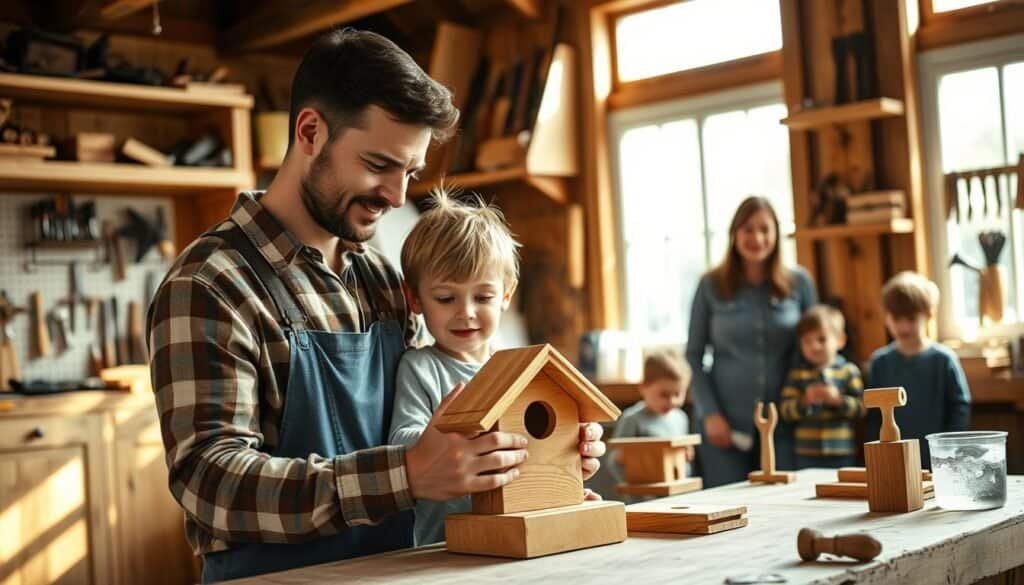
Choose projects that everyone can work on together. Simple projects like birdhouses or wooden picture frames are great to start with. As your family gets more skilled, you can tackle more complex projects.
Documenting your woodworking journey is also important. Take photos and videos of your projects. Keep a record of what you’ve made. This way, you can see how your skills have grown over time.
By following these tips, you can make woodworking a meaningful family ritual. It brings everyone together and creates lasting memories. Whether it’s a simple or complex project, the time spent together is what matters most.
Resources for Continuing Your Family Woodworking Journey
To keep your family’s woodworking journey going, it’s key to explore many resources. Woodworking offers a wide range of learning and growth opportunities.
Online tutorials are a great place to start. Websites like YouTube and woodworking forums have lots of instructional content. You can find everything from simple DIY projects to complex plans for beginners. These resources are perfect for families wanting to improve their skills and try new things.
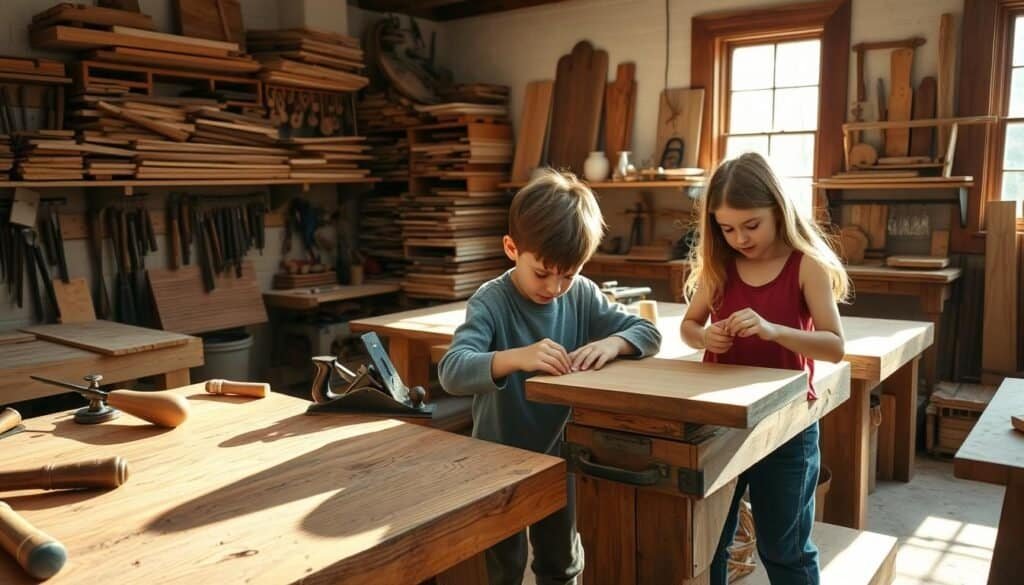
Books and magazines are also essential for woodworkers. They provide detailed guides and inspiration for projects, including unique ideas like laser cut map art. Local libraries and bookstores are full of resources for families looking to explore different woodworking projects.
Local woodworking classes are another great option. These classes offer hands-on learning and the chance to learn from experts. Many community centers, woodworking stores, and vocational schools have classes for families and beginners.
Joining a woodworking community or club is also very beneficial. These groups let you share ideas, learn from others, and find inspiration for new projects. They’re a great way to meet other families who love woodworking.
By using these resources, families can keep growing their woodworking skills. This creates a lasting tradition that can last for generations.
Conclusion: Crafting Memories That Last a Lifetime
Family woodworking is more than a hobby. It’s a way to make lasting memories with your loved ones. Through sawdust and creativity, you can build bonds that will last forever. This article has shown many ways to make woodworking fun and rewarding for families.
Start with simple projects and move to more complex ones. This way, you can create a tradition your family will love for years. The joy of making something with your own hands is unmatched. Whether it’s a birdhouse or a wooden gift, it’s a special feeling.
Keep documenting your progress and share your experiences. This helps you see how far you’ve come and inspires others to start their own woodworking traditions. With the right tools, safety, and a desire to learn, you can make a lifetime of memories through family woodworking.
So, gather your family and start your woodworking journey today. With patience, practice, and dedication, you’ll create memories that will be treasured for generations. You’ll also make beautiful wooden gift ideas that everyone will love.

